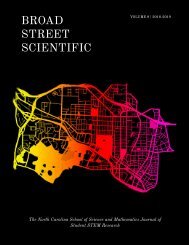Broad Street Scientific Journal 2020
Create successful ePaper yourself
Turn your PDF publications into a flip-book with our unique Google optimized e-Paper software.
emotional one-back task, the influence of the emotional
valence (i.e. whether a stimulus is neutral or negative) on
WM can be calculated.
The influence of emotion on cognition is an essential
topic to research, but research on this topic has received
less attention than others in schizophrenia literature. In
controls, it has been shown that emotional stimuli can
garner more attention than neutral stimuli. This extra attention
may facilitate the processing of emotional stimuli.
In patients with schizophrenia, there may be reduced activation
and worsened performance due to the addition
of emotional valence to the WM task. DLPFC has an important
role in the integration of emotional and cognitive
information [7]. Studies of negative valence and cognition
tend to produce more robust results due to the arousing
nature of the images used. Other studies [4] also explore
the interaction between EP and WM, but only with control
and schizophrenia patient groups. By including HR
participants, which have been found to show similar
working memory deficits as those with schizophrenia [2],
in our study of the interaction of WM and EP, we address a
new set of questions in how high-risk participants perform
compared to controls and RO and if they exhibit deficits
similar to RO participants.
The overarching goal of this study is to identify how
WM and emotional processes interact, particularly in the
context of schizophrenia. In order to achieve this aim, we
administered an emotional n-back task to 76 participants
(35 control, 20 HR, 21 RO) to determine group differences
in regional activation and WM performance associated
with psychotic illness. We hypothesized that RO participants
would perform consistently across neutral and negative
conditions (because emotional blunting may result in
less expressed performance differences between valences),
while control participants would have more impaired performance
in the negative condition compared to the neutral
condition. Moreover, we hypothesized that changes in
performance between conditions will differ between subject
groups. When looking at brain activation, we hypothesized
that the control participants would exhibit a greater
change in ventral regions when comparing between the
neutral and negative conditions and that control participants
would have a greater change in activation in WM
regions between neutral to negative. We also hypothesized
that genetic high-risk participants would exhibit brain activation
and task performance intermediate between CON
and RO. Finally, we investigated links between activation
and behavior to see if changes in activation correlated with
changes in task performance.
2. Methods
2.1 – Participants
Twenty-one patients with recent-onset schizophrenia
and twenty genetic high-risk patients were recruited from
the UNC Healthcare System. Thirty-five healthy control
subjects were also included. All participants provided
written consent to the study approved by the University
of North Carolina- Chapel Hill IRB. All participants were
between the ages of 16-45, of any ethnicities or gender,
had no presence of metallic implants or devices interfering
with MRI, and were not pregnant. Inclusion criteria for
recent-onset schizophrenia (RO) patients were: (1) Meet
DSM-IV criteria for SZ or schizophreniform disorder, (2)
No history of major central nervous system disorder or intellectual
disability (IQ<65), (3) Must have illness for <5
years, (4) No current diagnosis of substance dependence,
and no substance abuse for 6 weeks. RO patients were also
instructed to refrain from taking benzodiazepine medications
on the morning of testing but instead to bring their
medication with them to take after scanning. Inclusion
criteria for genetic high risk (HR) patients were: (1) Must
have first degree relative with psychotic disorder, (2) Must
not meet DSM-IV criteria for past or current Axis I psychotic
disorder on bipolar affective disorder, (3) No history
of major central nervous system disorder or intellectual
disability (IQ<65), (4) No current treatment with antipsychotic
medication. Healthy controls (CON) were excluded
if they had history of a DSM-IV axis I psychiatric disorder,
family history of psychosis, history of current substance
abuse/dependence, history or current medical illness that
could affect brain morphology, or clinically significant
neurological or medical problems that could influence the
diagnosis or the assessment of the biological variables in
the study. All participants gave written informed consent
consistent with the IRB of UNC if over 18 or assent and
parent/guardian provided consent for minors prior to
their participation in the study.
2.2 – Emotional One-back Task and Procedure
Each participant completed an emotional one-back task
with an auditory component during a functional magnetic
imaging (fMRI) session with 8 runs. The emotional oneback
task consists of a visual tracking task, using images
with either Positive, Neutral, or Negative valence, as defined
by the International Affective Picture System (IAPS)
[8]. Further analysis was performed with only Neutral and
Negative Valences. Patients with schizophrenia report
feeling negative emotion strongly but are less outwardly
expressive of this negative emotion [9]. By focusing on the
Negative valence, we want to observe if RO exhibit similar
activation to CON during negative emotional situations,
as the contexts in which RO patients experience negative
emotion is different than those without SZ. All images in
the run were of the same valence, and subjects were asked
to press a button when they saw the same image two times
in a row (Fig. 1). A control condition with no n-back
task was also included. The auditory component, which
occurred simultaneously with the visual component, involved
subjects hearing irrelevant standard and pitch devi-
26 | 2019-2020 | Broad Street Scientific BIOLOGY




